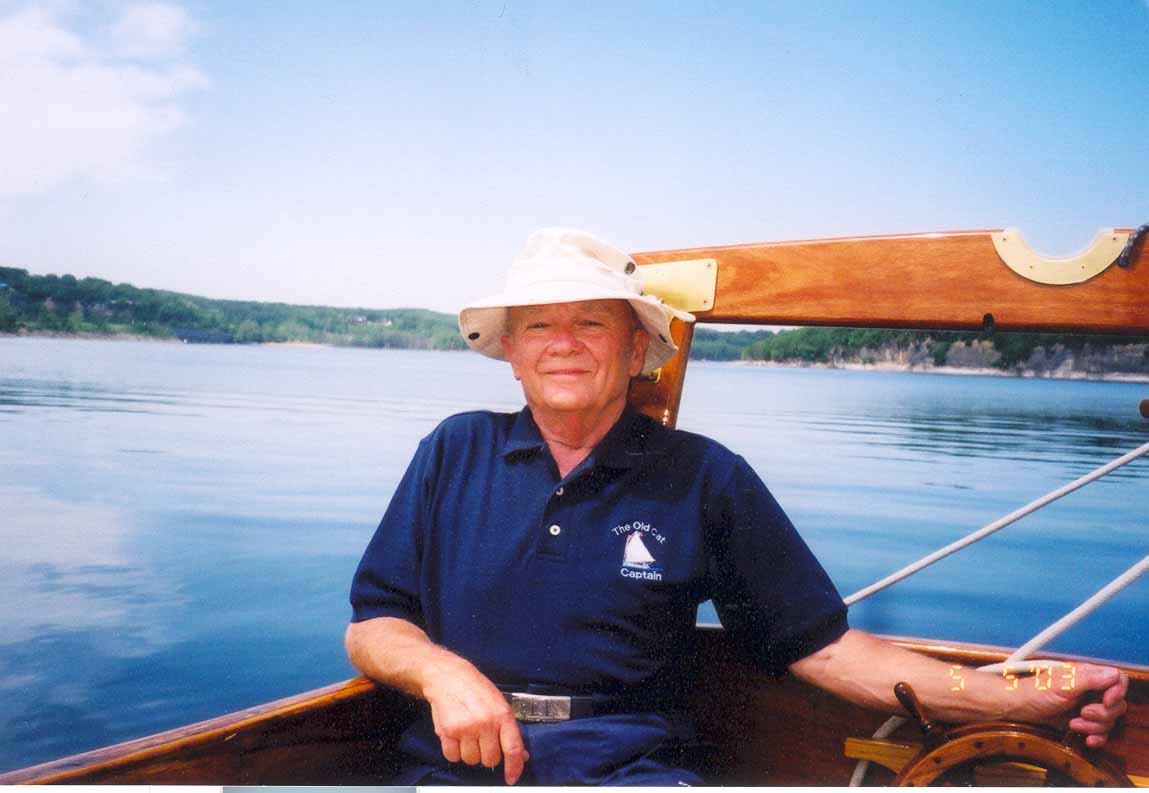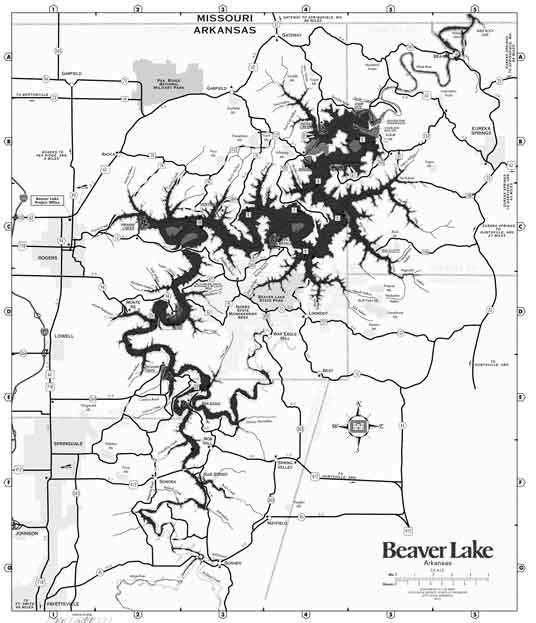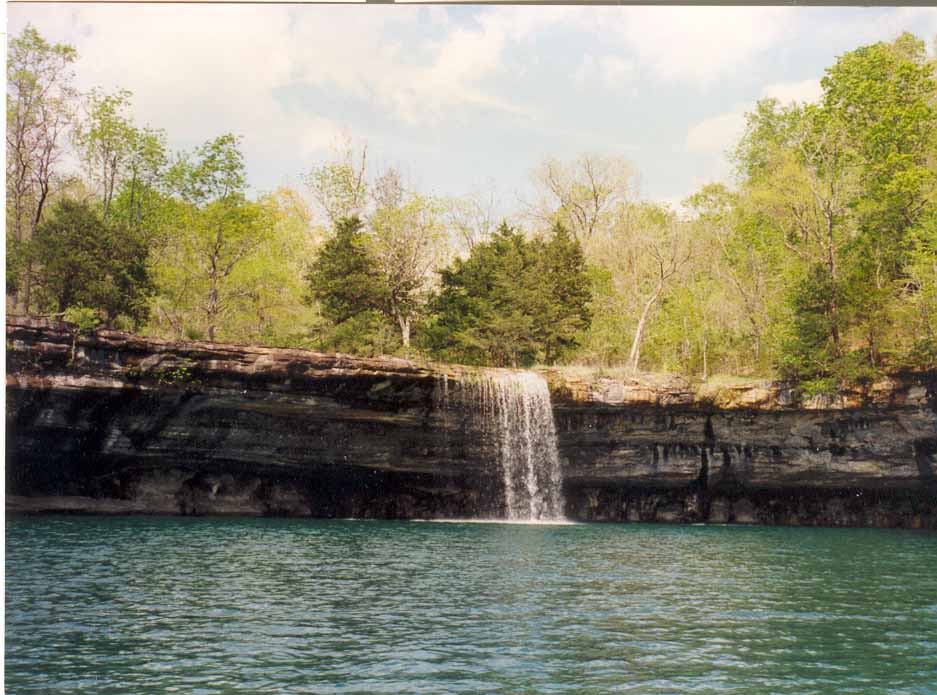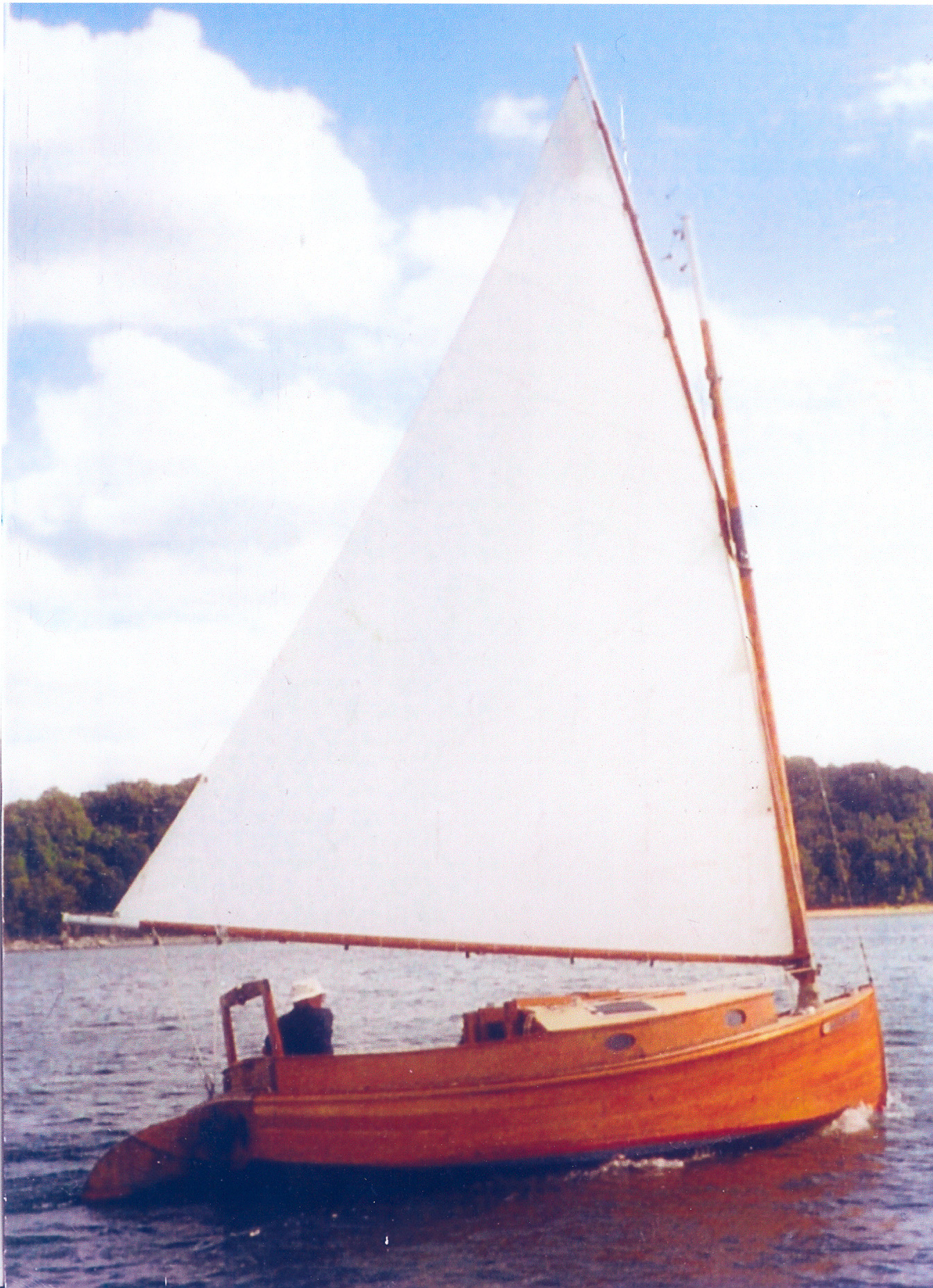 |
| Author Cdr John R. Butler relaxing on his sailboat. |
The
Beaver and the Cat
or Sailing a 40-Year-Old Boat on a
40-Year-Old Lake
By Cdr John R. Butler
The early 1960s were a significant time for both the beaver and the cat. But in spite of their diverse origins and backgrounds, each seems to enjoy the presence of the other.
Construction of Beaver Lake, the
beautiful (albeit man-made) impoundment
in northwest Arkansas, was started in
1960 and was generating electrical power
by 1965. Early fishermen were likely
drowning bait by 1964, and have never
quit.
 |
| Author Cdr John R. Butler relaxing on his sailboat. |
The lake can trace its legal origin to
the Congressional Water Supply Act of
1958. Its natural origin, however, is
much older: a spring in the Boston
Mountains, a range considered by some
experts to be the oldest in our country.
This water source, 2,000 feet high,
flows north to become the magnificent
White River. Other springs and
watersheds add to her flow, establishing
her as a major river.
The Old Cat can trace her own origin to
the same period as her lake. Her keel
was laid by the father-and-son team of
Christian W. Dahl, Jr. and Christian W.
Dahl, III in Minneapolis in 1963. She
was launched on Lake Minnetonka in 1964.
Based upon a Charles W. Wittholz, NA,
design, I think she is beautiful, too.
The origin of my Cape Cod Catboat's
design is not as historic as her lake,
but she can trace her history back to
commercial fishermen of Cape Cod, some
150 years ago. Those resourceful New
Englanders designed the craft to serve
the very specific needs of their
livelihood. They did their design work
so well, the resulting Cape Cod Catboat
was also adopted by commercial fishermen
in New Jersey and even down to the Gulf
Coast.
In fact, the design was so surprisingly
successful that it has remained
essentially unchanged to this day. And
my sailboat is very true to her
heritage. If I could just transport The
Old Cat back in time to the early 1850s
and tie her to one of the moorings off
Osterville, Massachusetts, commercial
fishermen would cast an approving eye
over her lines and rigging. Their
comments might sound like this:
"Looks just fine."
"Should market a good load of fish."
"She'll carry her sail well."
"Builder was a real craftsman. She's eye
sweet."
Eye sweet. The term seems to define
itself, but the history is unique. Long
ago, very long ago, before computers and
lawyers took over boat building plans
and contracts, there was a standard
clause in many boat building agreements:
"Boat to be perfectly fair and eye
sweet."
 |
| Scenic bluff with “location marker” number 8 at the shoreline. |
In those days the designer, builder and
future owner could look at a half model,
talk things over, sign a simple
document, shake hands, then share coffee
to seal the deal.
Cape Cod Catboats were, and still are
eye sweet, and any decent builder would
be certain that their lines were fair.
The design continues to be so popular
that several firms make accurate
fiberglass replicas, and diehard
traditionalists can still order one made
of wood. For a price, of course.
Good used catboats are always available,
and are found at http://www.catboats.org,
the web site of the popular and
worldwide Catboat Association. That is
where my old cat came from, and for only
$4,000, because few owners want the
intensive maintenance of a wooden boat
that is varnished, not painted.
Beaver Lake, on the other hand, was
completed in 1966 for over 10,000 times
more money, $46,200,000. It is the
first-in-line of several Corps of
Engineers ventures to tame the mighty
White River as it flows east to join the
Mississippi River.
Before it was dammed multiple times,
natives of the Ozark region probably
gathered on the river with inner tubes
from farm trucks and tractors to escape
the summer heat. In addition to full
baptisms in the fresh flowing river,
there likely were gravel bar picnics of
country fried chicken, homemade potato
salad, corn bread, and perhaps some
"corn squeezins". In the winter,
drifting downstream on a raft or jon
boat would provide both sport and fish
for the family table.
As the White flows east, it is fed by
another 10,000 springs. After leaving
Beaver Lake it forms, in succession, the
remainder of the "Great Lakes of the
White River": Table Rock and Bull Shoals
Lakes.
 |
| The new Beaver Lake map published by the Corps of Engineers shows no less than sixteen “Public launching ramps” in the lower left corner, but some of them require that old “local knowledge” to find them. The popular ones are at the Corp’s parks. I would personally recommend one they did not list, located on the north side of state highway 12, right at the west end of the long bridge over the lake. Map location C2.5, it is about six miles east of Rogers. The Arkansas Game and Fish Division wisely used properly identified tax receipts to pave, light and mark the area, and the two ramps are broad and gradual, easily accommodating four boats at a time. (The Old Cat’s home port is just a mile east, so I use it.) |
Home to Beaver Lake is the fastest
growing economic region in the country.
The local economy is fueled, in part, by
the home offices (and their many
vendors) of the world's largest retailer
(Wal-Mart) and the world's largest meat
company (Tyson), and several other major
corporations. Of course the lake cannot
claim responsibility for this boom, but
the growth could not have been supported
without its abundant and clean water
supply.
Lying in the northwest corner of
Arkansas, Beaver's 28,000 acres of
beautiful clear water with 450 miles of
shoreline is never without a wide
variety of boats enjoying the bounties
of flood control.
While most boats are for summer use
only, hardy souls and fishermen know
each season has its special advantages.
Fishermen from around the country flock
to Beaver Lake for superb fishing all
year. The popular B.A.S.S. fishing
tournaments got their start on Beaver
Lake in 1967, and the Wal-Mart FLW Tour,
with its "$1.5 million Championship
Format," includes Beaver Lake as one of
its seven destinations. The Central
Pro-Am Association also schedules
qualifying events here for its $650,000
series.
No fishing is done from The Old Cat, but
she does know that each season has its
own special sailing pleasures. Summers
tend to be hot and the winds more light
and variable, but picnic lunches in the
shade of a rock bluff, or diving from
the deck into the warm water makes up
for less than perfect sailing.
That perfect sailing usually comes in
the spring and fall when the lake is
less crowded and the winds fresh and
steady. Winter sailing can be
surprisingly good, with many days of
fine breezes and temperatures in the
50s.
The lake is, as you might guess,
serpentine, since it follows the beds of
the White and its tributary creeks, and
sailing is a constant challenge.
Straight stretches of the lake are
broken by abrupt U-turns, and the wide
areas are wide only in comparison to the
narrow runs.
The Old Cat is an ideal boat for such
sailing, for tacking a catboat involves
only in putting the helm to leeward. No
jib sheet to cast off, nor a flogging
sheet on the other side to tame and
winch in. No running back stays to tend.
Just "Ready about?", then "Hard alee!"
Cape Cod Catboats have their signature
"barn door rudders," very large to
control the many moods of the cat, and
they come about quickly. In fact, the
origin of the term "catboat" is lost in
history, but one story is that they are
"as nimble as a cat."
Another feature of these one-time work
boats is their very broad beam. As
commercial fishing boats, that gave them
great cargo capacity, plus exceptional
stability in the wide variety of weather
encountered off Cape Cod. Catboats
typically have beams that are nearly
half their length. The Old Cat measures
18' 6" overall, and her beam is a full
8' 6", so I don't have to switch sides
when coming about to keep my ballasting
weight to windward.
 |
| Picturesque rock bluff with its seasonal waterfall, dubbed “Mini-Tracy Arm” by author due to its small scale similarity with the end of a fjord on Southeast Alaska. |
Beaver Lake's many feeder creeks, once
streams rushing to join the White River,
are now coves with interesting names
like War Eagle, Rambo, Indian, Big
Clifty, Prairie, Hogscald and Coose.
These picturesque coves are now great
places to drop an anchor for an
overnight stay, and I like to rate each
cove with my own variety of standards.
The larger coves have many spurs that
invite exploration as destinations for
my mini-cruises. Some of the smaller
coves are seasonal because of the
possibility of shallow waters at varying
lake levels.
Varying lake levels? Yes, since Beaver
Lake is a Corps of Engineers
impoundment, authorized by Congress for
water supply, flood control,
hydroelectric power generation and
recreation, its level can rise
dramatically after extended heavy rains,
or drop just as dramatically during long
droughts and high demands for
electricity.
 |
| Author and his Cape
Cod Catboat The Old Cat
out on an afternoon’s
sail. Photo by Mary Lu Butler |
The normal, or "pool level," is 1,120
feet above mean sea level, but it
typically varies several feet above and
below. An all time high was reached, in
April of 2002, of 1,130.37', and the
lowest level was 1,092.92' in January of
1977. That is an astounding range of
37.45', but normal fluctuations are more
in the single digits from pool level.
So, some of my overnighting coves become
unusable at low levels.
Scenic beauty is always important for my
cove ratings, and beautiful stone bluffs
and verdant shorelines add many points.
One of the spur coves off Big Clifty
Creek is Penitentiary Hollow which
splits into a "Y" with a waterfall over
a rock bluff pouring into each fork.
While the southern fork has a private
home overlooking the waterfall, the
northern one is still as primitive and
scenic as one could wish.
In scenic beauty, it is a rival, at
perhaps one tenth scale, to the end of
Tracy Arm in Southeast Alaska, where
each fork has a portion of the Sawyer
Glacier calving at its end, instead of a
clear waterfall. We anchored off one of
those glaciers back in 1970 while
cruising in a vintage Owens "Sedan
Cruiser." One of my strange habits is to
name each cove that I frequent, so of
course I named this spur cove
"Mini-Tracy Arm."
Another of my rating factors is the
privacy or seclusion each cove offers.
L. Francis Herreshoff, in his book
"Sensible Cruising Designs," extols the
virtues of good cruising sailboats (his
designs, of course), and of the joys of
"Undisturbed reading--ah, yes, this is
one of the objects of the cruise."
Along with undisturbed reading while
anchored in my secluded coves, I also
like the privacy should I wish for a
quick swim without getting my suit wet.
In its upper reaches, especially during
periods of low water, Beaver Lake can be
quite shallow, often good only for
canoeing or kayaking, and fishing of
course. But most sailors solve this
problem by sailing beyond the state
highway 12 bridge which rather cuts the
lake in two. Downstream from the bridge,
mostly to the east, the lake has fine
depths, sometimes well over 170 feet.
The free Corps of Engineers map (not a
chart, no water depths indicated) is
sufficient for casual sailing. For the
serious sailor and gunkholer, go to one
of the many stores catering to fishermen
and buy one of the maps made from old
topographic maps dating back before the
White was flooded.
These maps will not only provide fine
detail, they have interesting features.
For instance, as I pass over the
one-time "Butler Cemetery," I am sure to
doff my sun hat. The cemetery's location
now lies some 80 feet below the surface.
There are shallows, to be sure,
especially up the coves, and The Old Cat
draws 32", so I do watch my sounder.
Almost as good is eyeball sounding,
however, for the bottom shows yellowish,
from a short distance away, when the
depth is below some four to five feet.
Cape Cod Catboats are normally equipped
with large centerboards, The Old Cat
included. They were essential to the
commercial fisherman working the
shallows, and are still desired by
pleasure sailors desiring a competitive
edge when racing.
Since I am neither a commercial
fisherman nor competitive sailor, and
the centerboard trunk intruded into the
cockpit and divided the spacious cabin,
I converted to a keel, losing about a
foot of shallow water capability, but
gaining much in convenience and
roominess. A great bargain for me.
A spacious cabin on an 18' boat? Not
really, of course, but the broad beam,
high freeboard and steep crown does make
it roomy and comfortable. Since I never
eat, read or sleep standing up, I don't
miss the lack of "full headroom," and
there is plenty of room for sitting and
moving about. Some catboaters, myself
included, find more comfort and security
in their small cabins, than that felt in
a modern yacht.
Another signature characteristic of
catboats is the mast being stepped on
the keel and very close to the bow, so
there is no mast to dodge in the cabin.
There is abundant storage under the two
vee berths, and the space between the
feet of the berths that housed a head
before pollution rules outlawed
overboard dumping, adds more space. Now
Herreshoff's solution for a head works
fine for me, except his oaken bucket has
been replaced by a hard rubber farm
bucket, good also for cleaning ship.
For quiet evenings at anchor, I have
devised a cross between a hammock and a
recliner, quickly and easily rigged
across the cabin and most comfortable.
And for cool mornings, or winter
cruising, a small stove of my design
keeps my cabin toasty. I have tried
wood, coal and charcoal briquettes, but
have found the natural oak charcoal is
the best by far.
My stove opens the entire year to
overnight "cruises," and it has kept me
cozy while a bucket of water froze in
the cockpit.
Commercial fishing from catboats
declined rapidly with the advent of
practical inboard engines about the turn
of the century (1900 to 2000, that is!),
making the powerful gaff sail
semi-obsolete, but many catboats today
still have inboard engines, now usually
small diesels.
The Old Cat had the beautiful little
Atomic Two, a genuine marine engine,
when I bought it, but Tom (The Old
Motor) expired of old age a few years
ago. So, with repair parts no longer
available, I repowered with a used two
horsepower golf cart electric motor, a
new electronic power controller, and a
bank of batteries in the bilge. Kitten
(because of her soft purr when running)
will push us to hull speed, or idle down
to an imperceptible speed. And Kitten's
endurance is fine for my lake: I can
return from the farthest reaches, if the
wind fails, at about four knots.
While Kitten may push The Old Cat to her
theoretical hull speed of 5.68 knots
(6.5 miles per hour), her large sail has
pulled her to 7.39 knots in a broad
reach with a capful of wind.
Cape Cod Catboats' sails are powerful:
They were designed to develop enough
power to drag oyster dredges over the
bottom in a light breeze, yet could have
as many as four rows of reef points to
shorten the canvas to a mere rag so
fishing could continue in a really hard
blow.
The Old Cat's sail measures 270 square
feet, huge compared to most small
sailboats. While the luff is just a
couple feet aft of the bow, the very
long boom (another signature
characteristic) extends far beyond the
transom. Sailing in a freshening breeze
can be a thrill--or a challenge! And the
catboater's mantra is "reef before you
even think you might need it."
When the wind fails, or you're in a
runabout or jet ski, beaching to do a
bit of hiking or beach combing is always
popular, especially on the deserted
islands. A word of caution to hikers:
Beware of the "Bane of the Ozarks," the
chiggers and ticks. Check with locals
about cautions and cures. Conversely, I
rarely see more than one mosquito a
year. Thanks to the bats?
While all of the graveyards were moved
before the lake was flooded, remains of
old farms and homesteads may still be
discovered. One afternoon, during high
water, My granddaughter and I paddled my
canoe right into the remains of an old
cement farm building, probably a milking
house.
With the anchor set, sail furled and the
sun "well over the yardarm," an evening
libation in the broad cockpit can be so
gentle and rewarding. As dusk settles
in, the careful eye will observe a few
bats swooping overhead, cleaning up any
remaining bugs in the air.
Do you especially enjoy Mother Nature's
sounds? How about these, all heard in
one or more of my favorite overnighting
coves: the basso profundo of bull frogs,
the comforting and endless calls of the
whippoorwills, a variety of owls, a wild
turkey's gobble, the yap of a coyote or
the snarl of a wild cat.
An early catboat builder, H. Manley
Crosby, one of the eight generations of
Crosbys building catboats, expressed it
well for this old man and his old boat:
"There's nothing like a good boat to
make a man feel young again." And a
beautiful lake to sail on makes it all
quite perfect.
Cdr Butler retired from the Coast
Guard in 1974 after prior Navy enlisted
service, flying SAR in amphibious planes
and helicopters on the West Coast,
Phillipine Islands, Gulf and East Coasts
and Alaska. A desk job in New Orleans
lead him to retire. Always a sailor, he
sailed a snipe as a kid, then a variety
of sailboats from the classic Pearson
Triton to the capable Montgomery 15. He
crewed on a 102’ schooner in The Tall
Ships Race during Australia’s
Bicentennial Celebration in 1988. His
present wooden catboat is kind to his
increasing age and physical
disabilities, and is thoroughly
described at <http://community.webtv.net/theoldcat/TheOldCat>